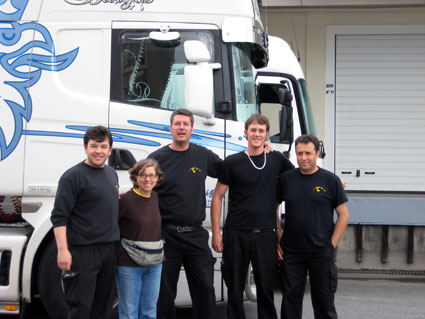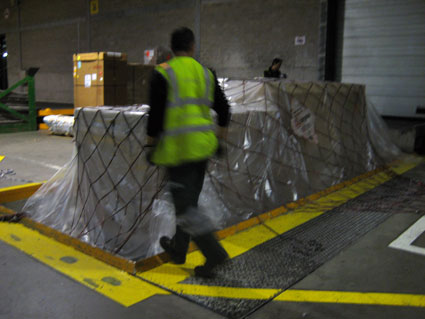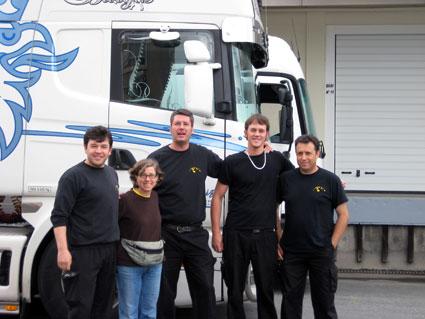A lot of people think that art museum curators lead a totally glamorous life, as if we’re always sipping champagne with the queen. There is a kernel of truth to that (well, I’ve toasted with Prince Charles, if not with Queen Elizabeth), but there is also the decidedly unglamorous, nitty-gritty side to the curator’s life.
I recently couriered Takashi Murakami’s big triptych in LACMA’s collection, PO + KO Surrealism (Green) (1999), back from the Guggenheim Museum in Bilbao, Spain, where it had been on loan for an exhibition. What does couriering really entail? After carefully checking on the condition of the large (over 9 feet tall and almost 14 feet wide) triptych in the storeroom of the museum in Bilbao, I oversaw the packing of the three panels into two huge crates, and the next day watched as the two crates were loaded into a gigantic truck. After what seemed like forever—as requested, I had arrived at the Guggenheim Bilbao at 8 am that morning to oversee the loading—the air-ride, climate-controlled truck, filled completely with various Murakami crates ultimately headed for London and New York as well as Los Angeles, finally pulled out of the loading dock at 2 pm.

Drivers Feday, Ricard, Mark, and Pedro with LACMA curator Carol Eliel, right before starting the Paris-Luxembourg leg of the courier trip. Carol drove in the truck with Feday and Mark (and the Murakami crates), with Ricard and Pedro in the second truck.
I rode in the cab of the truck with two interesting and charming truck drivers, Mark and Feday. It was frustrating to drive through northern Spain and southwestern France—known for great food and fine wines—only to eat dinner at a highway rest stop, but the landscape was beautiful and the summer day long. However, it was pitch-dark when we pulled into the secure art warehouse on the gritty, industrial outskirts of Paris at 2 am. (How frustrating to be at the end stop of one of the Paris metro lines and not be able to go into the city center!) After six hours’ sleep, a refreshing shower, and a quick breakfast at our Motel 6 equivalent, we hit the road again for the eight-hour drive to Luxembourg, the nearest airport to Bilbao with freighter service.
Because LACMA’s Murakami crates were so large, they wouldn’t fit in the smaller cargo belly of a passenger plane—they needed to go on a much more commodious freighter flight. After arriving at the Luxembourg cargo terminal and overseeing the removal of the crates from the truck, I watched as the CargoLux staff put together an oversized pallet and loaded onto it my two crates along with several others destined for Los Angeles. By the time the pallet was plastic-wrapped and moved to climate-controlled overnight storage, it was close to midnight and all I could find for dinner was a side order of soggy French fries at the cargo workers’ commissary!

Workers in the CargoLux cargo terminal in Luxembourg wrapping the pallet with LACMA’s Murakami crates.
On day three of this long and arduous journey I finally saw my pallet safely fixed in place inside the cargo plane—along with cars, jet engines, and other oversized items—and I settled into the small but comfortable passenger area of the plane for the twelve-hour flight to Los Angeles. Even when we arrived in L.A. my courier trip wasn’t over. After clearing immigration myself (by which point the cargo had been unloaded from the aircraft), I had to wait for the crates’ paperwork to be cleared, for the pallet to be unwrapped, and for LACMA’s crates to be loaded into a waiting truck. From LAX we drove to the museum, unloaded the two giant crates, moved them into secure storage at LACMA…and finally, having been up for twenty-four hours straight after two days in the truck, I could go home and sleep in my own bed. So much for glamour!
Carol S. Eliel, Curator of Modern and Contemporary Art



